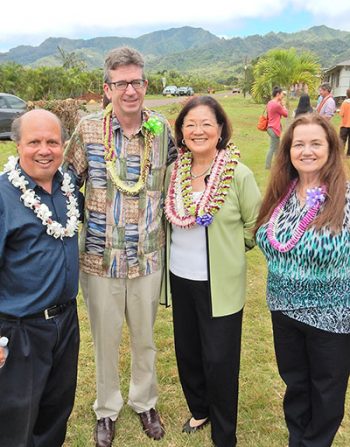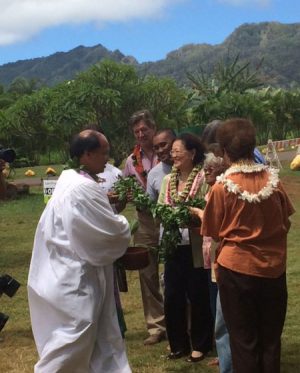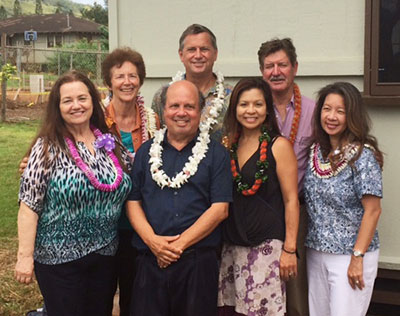By Elizabeth Zach, RCAC staff writer

Recently, RCAC staff joined staff from the Hawaii Agriculture Research Center (HARC), United States Sen. Mazie K. Hirono, Hawaii state senators Suzanne Chun-Oakland and Gil Riviere, and Kahu Cordell Kekoa in blessing the first of 82 renovated or new affordable homes for low-income farmworkers in Kunia Village on the Hawaiian island of Oahu. Many residents who were born and raised children, grandchildren and great grandchildren on the land were in attendance.
Kunia Village was part of the former Del Monte pineapple plantation, which operated on the island from 1916 until 2007 and provided workforce housing to plantation workers. When the company closed its operations, it laid off 551 workers, and put residents in jeopardy of losing their homes. The land owner, Campbell Estate, sold it to HARC for $1.00 in exchange for an agreement to continue to provide affordable rental housing. HARC did not have housing experience, so RCAC agreed to develop a strategy to preserve the housing, eventually entering into its first housing development partnership.
“From the beginning and still now, it’s a great cooperation with RCAC, and all other agencies and our subsidiaries that helped make this project possible,” said Stevie Whalen, HARC’s executive director.

RCAC’s Development Solutions staff developed a financing plan. It included securing $6 million in U.S. Department of Agriculture Rural Development farmworker housing loans and rental assistance for families living in 75 of the homes. Next, RCAC’s Loan Fund provided predevelopment financing to cover architectural and engineering expenses. Additional project financing included federal, state and historic low-income tax credits, solar energy credits, tax-exempt bond financing and a 538 USDA guaranteed loan. Meanwhile, Development Solutions staff helped HARC successfully apply for Historic Designation; and Kunia Village was added to the National Register of Historic Places in 2014. Development Solutions staff also helped HARC to work with USDA so that low-income subsistence farmers could qualify for the housing.
RCAC provided Kunia with a $6 million loan which, coupled with $20,935,000 in tax-exempt bond financing from Wells Fargo, went to renovate 45 existing rental units and demolish another 19 before constructing 37 new rentals for farmworker families, many of whom have extremely low median family incomes. Kunia Village intends to provide up to 200 affordable rental units for agricultural workers in the next 20 to 30 years.

This phase of the project is close to 50 percent complete. The ongoing restoration work includes a church, post office, community center, neighborhood store, warehouses, offices and a wastewater treatment plant. RCAC’s Joy Gannon provided environmental technical assistance for the sitework as well.
In the first phase of the redevelopment, the 37 new homes will resemble plantation-style homes. Renovation work includes foundation, floor and wall repairs, new wiring, painting, roofing, light fixtures, appliances, cabinets, countertops, sinks, toilets, showers and tubs. The repairs and new construction will substantially increase the energy efficiency of the development and will meet the requirements of Leadership in Energy Efficient Design (LEED) and Enterprise Green Build programs.
